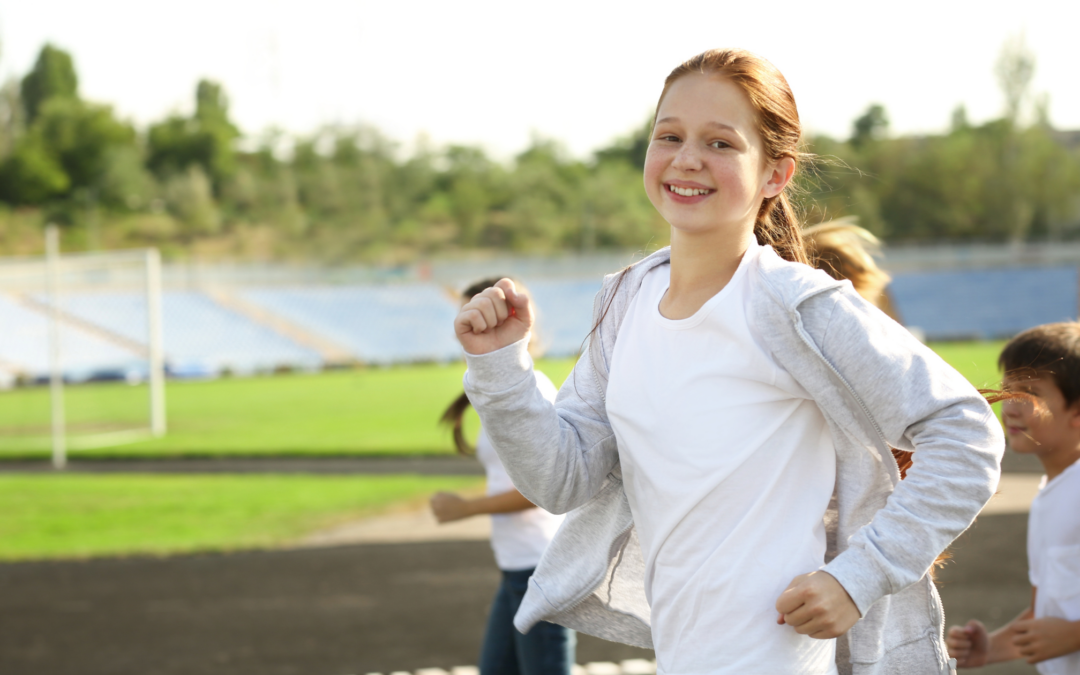Why You Should Homeschool Physical Education
Recently, I wrote a blog post, Homeschooling Physical Education. It outlines different ideas for integrating physical education into your homeschooling program.
Today, we return to the theme of physical education with a question I’ve received: “Why homeschool physical education at all? I make sure my kids stay busy, and they are always rambunctious and engaging in active play. It seems like that should be enough.” In this article, I will reflect on why you may want a more intentional approach to physical education. This goes beyond just letting the kids play.
Getting Energy Out ≠ Physical Education
The above question demonstrates that people often equate physical education with kids merely “getting their energy out.” Now, don’t get me wrong—it’s great to give children ample opportunities to work out their squirms and burn off pent-up energy! But it’s also important to understand that physical education is not merely about letting kids get their energy out. It’s an actual educational regimen that trains the body and imparts a framework of knowledge about how the human body works.
Let’s use an analogy. Imagine teaching your children handwriting. Would it be enough to just give them crayons and let them color, allowing them to express their creativity? While it’s great to give kids the opportunity to exercise their creativity, we also understand that it is fundamentally different from learning the discipline of handwriting. Similarly, we need to understand that burning off energy isn’t the same as physical education.
Countering the Modern Sedentary Life
Even if your kids get a good amount of active play each day, consider the increasingly sedentary nature of modern life. With more work and school being accomplished online and remotely, people are spending more time sitting than ever before. Current studies suggest that modern Americans spend an average of 6.5 to 8 hours per day sitting. Spending so much sedentary time can have negative health consequences, especially when stretched out over several years.
To give our children the skills to counteract this trend, we need to be more deliberate. We will need to counter the sedentary habits of modern life. This starts by nurturing active habits—not merely letting the kids run around when they get antsy. Fostering a lifestyle intentionally crafted with physical fitness in mind goes a long way.
The Abysmal State of Food
The prevalence of obesity in American youth is well-attested. Today, a whopping one in every five adolescents is classified as clinically obese (source). If you are homeschooling, you are likely already conscientious about the abysmal state of food. You avoid greasy, deep-fried foods, and don’t let your kids have too many sweets. You probably buy locally sourced produce when possible. However, avoiding fast food and sweets might not be sufficient.
Today, there is increasing concern about the health effects of processed foods, which are foods that have been altered from their natural state. Not all processing is bad. Processing increases shelf life, makes food easier to prepare, reduces waste, and can add nutrients to food (for example, yogurt enriched with additional protein or probiotics). But processing exists on a spectrum.
Some foods are so heavily processed that they are considered “ultra-processed.” These are foods that have unhealthy ingredients added to them, usually for purposes of taste, preservation, or aesthetics. Loaded with sodium, sugar, and additives, ultra-processed foods are low in nutrients and high in calories. With as much as 60% of the modern American diet consisting of ultra-processed foods, it’s no wonder we have such an obesity problem. Deli meats, bread, margarine, cereal, breakfast sausage, and many items we eat every day are ultra-processed.
To bring this back to physical education, a solid physical education should not only train the body but impart knowledge about how the body functions, including the concepts relating to food and nutrition. (Here is where P.E. could admirably overlap with a health or nutrition class.) Given the current state of our food and the epidemic of childhood obesity, we owe it to our children to give them the knowledge they need to make informed decisions about food, exercise, and the right care of the body. This is all way beyond what can be accomplished by just “letting them play.”
Declining Testosterone Levels
Another reason for a more structured physical regimen is the problem of decreasing testosterone levels in men. Research has consistently shown that testosterone levels in young men are decreasing and have been so for many years; some estimate a decline of around 1% per year since the late 1970s (source and source). While the cause of this is the subject of great debate, the effects of low testosterone over time are well-attested: inability to concentrate, mood swings, infertility, decreased muscle mass, inability to grow facial hair, and much more.
Regular physical exercise is an excellent and proven way to stimulate the body’s production of testosterone over time (source). The best exercises to increase testosterone in men are resistance training (i.e., weightlifting) and HIIT training (High-Intensity Interval Training), which consists of intense intervals of extreme exertion punctuated by periods of rest. For example, sprinting as fast as you can for 90 seconds and then resting for 90 seconds.
The point is these sorts of exercises require high levels of exertion that you’re typically only going to get with a structured training regimen. This sort of training can be especially helpful for boys during puberty when testosterone levels are naturally increasing, and the body is putting on muscle mass. But again, this requires way more than just sending your son out to play with his siblings in the yard.
Consider Your State Standards
Finally, you really need to keep your state standards in mind. Your state may have well-defined standards and requirements for physical education that are not met by merely letting your children play. In the state of Michigan, for example, our standards make it clear that P.E. is not simply about “being active” but being active in a structured way that helps children master specific skills. While those skills are basic at elementary ages (e.g., running, skipping, etc.), by high school, they get quite specific; jumping rope, volleying a ball, and utilizing strategy in team-based games are all mentioned.
If your kids are just playing outside at lunchtime, you may be unable to count that towards P.E. if it is not structured and does not incorporate the required standards. Again, it depends on what is required in your state, but in general, just letting your kids play or taking them on walks will fall short of what is required for P.E.
Conclusion: Building Healthy Life Habits
The point of physical education is simply that—to educate children about the distinctively physical aspects of their existence, especially through training and nutrition. Ultimately the purpose of P.E. is to nurture healthy physical habits in your children so that they can take care of themselves physically and make healthy choices about how they live. The overarching goals of a homeschool P.E. program should be building good habits of life, teaching physical discipline through exercise, and educating children about the mechanics of the body. While it’s always great to let your kids play and get their energy out, perhaps think about incorporating a more structured physical education component as you plan your homeschool year.
Online Resource
Homeschool Connections offers a variety of online courses that may count toward P.E., including:
- Middle School Health and Fitness
- Introduction to Physical Education and Health
- Sports and Recreation for Everyone
- High School Health I: Fitness
Remember to check out the blog post that inspired this article: Homeschooling Physical Education. There, you will find ideas to help you create an intentional, comprehensive P.E. program.
What about you? How have you tackled physical education in your homeschool? Join me and other homeschooling parents at our Homeschool Connections Community or our Facebook group. We’d love to hear about your favorite homeschool P.E. ideas or answer your questions!






